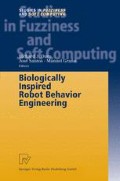Summary
In this chapter, we present a motion generation and adaptation method for dynamical motion. First we introduce a self-scaling reinforcement learning algorithm for fuzzy controllers and we apply it to the control of a robot with a single actuator. We then extend the controller and the learning algorithm in order to control a robot with multiple degrees of freedom. In this case, a hierarchical behavior-based controller architecture is used to simplify the design process. Finally we introduce the Newton Raphson method so as to adjust a hierarchical behavior-based controller through an on-line learning process to some modifications in the environment or task. The methods proposed are applied to a brachiation robot control, both in numerical simulations and in real experiments. This brachiation robot has been developed to imitate a long-armed ape.
Access this chapter
Tax calculation will be finalised at checkout
Purchases are for personal use only
Preview
Unable to display preview. Download preview PDF.
References
L. Davis (ed.), “Handbook of Genetic Algorithms”, Van Norstrand Reinhold, pp. 61–70, (1991)
M A. Lee, H. Takagi, “Integrating Design Stages of Fuzzy Systems using Genetic Algorithms”, ICNN, pp. 612–617, (1993)
H. Nomura, et al., “A Self-tuning method of Fuzzy Reasoning by Genetic Algorithm”, Proc. of the Int’l Fuzzy Systems and Intelligent Control Conf., pp. 236–245, (1992)
S. Horikawa, T. Furuhashi, et al., “A Study on Fuzzy Modeling using Fuzzy Neural Networks”, Proc. of IFES, pp. 562–573, (1991)
C. M. Higgins, R. M. Goodman, “Learning Fuzzy Rule-Based Neural Networks for Function Approximation”, Proc. of IJCNN, vol. 1, pp. 251–256, (1992)
R. Katayama, Y. Kajitani, K. Kuwata, et al., “Self generating radial basis function as neuro-fuzzy model and its application to nonlinear prediction of chaotic time series”, IEEE Int’l Conf. on Fuzzy System, pp. 612–617, (1993)
D. Whitley, T. Strakweather, and C. Bogart, “Genetic Algorithms and Neural Networks: Optimizing Connection and Connectivity”, Parallel Computing 14, pp. 347–361, (1990)
T. Fukuda, H. Ishigami, et al., “Structure Optimization of Fuzzy Gaussian Neural Network using Genetic Algorithm”, Proc. of ICAM, (1993)
T. Furuhashi, K. Nakaoka, Y Uchikawa, “An efficient finding of Fuzzy Rules Using a New Approach to Genetic Based Machine Learning”, Proc. of the FUZZIEEE/IFES, pp. 715–722, (1995)
Gullapalli, V., “A stochastic reinforcement learning algorithm for learning real-valued functions.”, Neural Networks, 3, pp. 671–692, (1990)
Gullapalli, V., Franklin, J.A. and Benbrahim, H., “Acquiring Robot Skill via Reinforcement Learning”, IEEE Control Systems, 14, pp. 13–24, (1994).
F. Saito, T. Fukuda, F. Arai, “Swing and Locomotion Control for a Two-Link Brachiation Robot”, IEEE Control Systems, Vol. 14, No. 1, pp. 5–12, (1994).
F. Saito, T. Fukuda, F. Arai, “Swing and Locomotion Control for Two-Link Brachiation Robot”, 1993 IEEE International Conference on Robotics and Automation, Atlanta, pp. 1 I: 719–724, (1993).
T. Fukuda, H. Hosokai and Y. Kondo, “Brachiation Type of Mobile Robot”, Proc. IEEE Int. Conf. Advanced Robotics, pp. 915–920, (1991).
T. Fukuda, F. Saito and F. Arai, “A Study on the Brachiation Type of Mobile Robot(Heuristic Creation of Driving Input and Control Using CMAC)”, Proc. IEEE/RSJ Int. Workshop on Intelligent Robots and Systems, pp. 478483, (1991).
M. W. Spong, Swing Up Control of the Acrobot, Proc. 1994 IEEE International Conference on Robotics and Automation, pp. 2356–2361, (1994)
Yamafuji, K., Fukushima, D. and Maekawa, K., Study of a Mobile Robot which can Shift from one Horizontal Bar to Another Using Vibratory Excitation, JSME Int. J., Ser. III, Vol. 35, No. 3, pp. 456, (1992).
Paul, R. P., Robot Manipulators, MIT Press, pp. 157, (1981).
K. Shimojima, T. Fukuda, Y. Hasegawa, RBF-Fuzzy System with GA Based Unsupervised Learning Method, Proc. of FUZZ-IEEE/IFES’95, Vol. 1, pp. 253258, (1995).
J. S. Albus, Outline for a Theory of Intelligence, IEEE Trans. on Systems, man, and Cybernetics, Vol. 21, No. 3 1991.
J. H. Connel and S. Mahadevan, Robot Learning, Kluwer Academic Publishers, 1993
S. D. Whitehead, J. Karlsson and J. Tenenberg, Learning Multiple Goal Behavior Via Task Decomposition and Dynamic Policy Merging, chapter 3 in Robot Learning, Kluwer Academic Publishers, 1993
E. Uchibe, M Asada and K. Hosoda, Behavior Coordination for a Mobile Robot Using Modular Reinforcement Learning, Proc. IROS, pp. 1329–1336, 1996
T. Fukuda Y. Hasegawa K. Shimojima and F. Saito, “Self Scaling Reinforcement Learning for Fuzzy Logic Controller”, IEEE International Conference on Evolutionary Computation, pp. 247–252, Japan, (1996)
J. Nakanishi, T Fukuda and D.E. Koditschek, “Experimental implementation of a ”Target dynamics controller on a two-link brachiating robot“, IEEE International Conference on Robotics and Automation, pp. 787–792, (1998)
Y. Hasegawa and T. Fukuda, “Learning Method for Hierarchical Behavior Controller”, IEEE International Conference on Robotics and Automation, pp.2799–2804, (1999)
E.L. Simons, Primate Evolution:An Introduction to Man’s Place in Nature, Macmillan, (1972).
Author information
Authors and Affiliations
Editor information
Editors and Affiliations
Rights and permissions
Copyright information
© 2003 Springer-Verlag Berlin Heidelberg
About this chapter
Cite this chapter
Fukuda, T., Hasegawa, Y. (2003). Behavior Coordination and its Modification on Monkey-type Mobile Robot. In: Duro, R.J., Santos, J., Graña, M. (eds) Biologically Inspired Robot Behavior Engineering. Studies in Fuzziness and Soft Computing, vol 109. Physica, Heidelberg. https://doi.org/10.1007/978-3-7908-1775-1_2
Download citation
DOI: https://doi.org/10.1007/978-3-7908-1775-1_2
Publisher Name: Physica, Heidelberg
Print ISBN: 978-3-7908-2517-6
Online ISBN: 978-3-7908-1775-1
eBook Packages: Springer Book Archive

